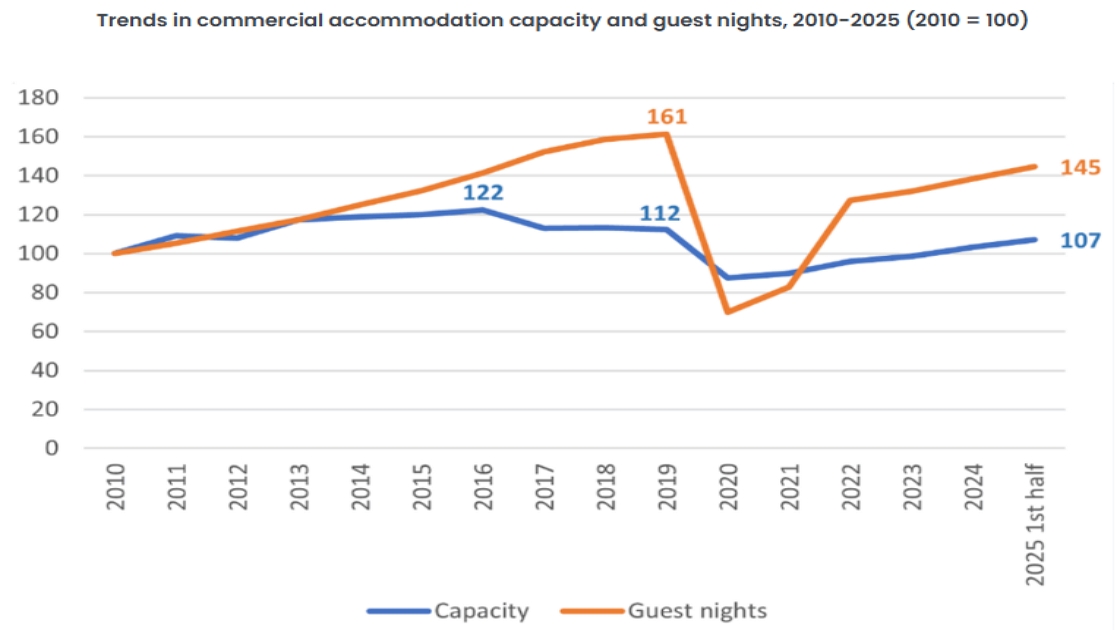Overview of Hungary’s Tourism Growth
In the first half of 2025, Hungary’s tourism industry saw a remarkable uptick in activity, hosting approximately 8.2 million guests who accounted for around 18.9 million overnight stays. This represents a 7.8% increase in guest numbers and a 4.5% increase in overnight stays compared to the previous year. Notably, hotels accommodated 57% of the guests and generated 55% of the overnight stays. This substantial growth is indicative of broader trends in tourism, reaffirming the sector’s critical role in supporting economic recovery.
The Economic Impact of Tourism
Tourism is a key driver of economic growth, with the potential to bolster the GDP through various channels, as highlighted by the economic research institute GKI in their analysis. An increase in overnight stays directly boosts the value added within the accommodation and hospitality sector, while the ‘multiplier effect’ from tourist spending enhances demand across other sectors, such as transport, retail, and cultural services. Additionally, spending by foreign visitors has a positive impact on the current account’s services balance, improving Hungary’s foreign-currency position.
Challenges and Recovery from COVID-19
Despite these positive trends, the latest statistics from the Central Statistical Office (KSH) indicate that Hungary’s tourism sector continues to recover from the pandemic’s impact measured in overnight stays. After experiencing a sharp decline in 2020 and partial recovery in 2021-2022, guest traffic has been on an average annual growth rate of about 4% over the past two-and-a-half years—enough to reach only 90% of the pre-pandemic levels seen in 2019. With this ongoing pace, analysts predict that the sector may regain its pre-COVID stature by 2028.
Foreign Visitors Driving the Tourism Recovery
Since 2021, the resurgence in tourism has predominantly been fueled by inbound tourism, with foreign travelers accounting for a staggering 83% of the growth in overnight stays during this recovery phase. The decade preceding the pandemic saw a significant increase in foreign trips to Hungary and the duration of visits. However, following the initial recovery phases, the growth appears to have plateaued, with current inbound tourism statistics still falling 17% short of the 2019 peak in both the number of trips and duration of stays.
Historical Context of Hungarian Tourism
The historical roots of tourism in Hungary can be traced back to the 18th century, with the industry evolving substantially until the onset of World War II. Post-1945, tourism was predominantly state-managed and focused on domestic and social tourism. Following Hungary’s transition to a market-based economy after 1989, the tourism sector experienced unprecedented growth, further accelerated by the nation joining the European Union in 2004, which opened up new legal and market opportunities.
According to data from the national tourism office, the direct contribution of the sector to GDP stands at about 5.9%, creating over 323,000 jobs, or 8.4% of total employment. The main tourism magnets, Budapest and Lake Balaton, remain pivotal, reflecting Hungary’s ongoing strategy geared towards addressing the needs of high-yield tourists and enhancing competitive advantages in tourism.
Future Projections and Trends
Looking ahead, Hungary’s tourism sector is expected to continue its positive trajectory, aligning with broader trends in international tourism, which increasingly favor unique cultural and natural experiences. Previous studies emphasize the importance of adapting to changing consumer demands and maintaining sustainable practices to ensure long-term viability.
Potential Developments in Hungarian Tourism
- Focus on high-quality amenities and services
- Increased promotion of cultural, ecological, and sporting tourism
- Improvement in tourism infrastructure and regulations
- Strategic marketing initiatives targeting key international markets
The Hungarian tourism industry is at a pivotal moment, capable of positioning itself as a leader in cultural and adventure tourism within Europe. With the right strategies, the sector can leverage its unique heritage and natural beauty to attract visitors not only to its cities but also to its lakes and rural landscapes.
Conclusion
The recent surge in Hungarian tourism reflects an exciting opportunity for the country as it works on revitalizing its economy post-pandemic. By enhancing tourist experiences and promoting its awe-inspiring landscapes and rich history, Hungary can ensure a bright future for tourism. For those seeking adventures on the water, GetBoat.com is an excellent platform for renting a yacht or sailing boat, providing tailored experiences for every traveler looking to navigate Hungary’s beautiful lakes and rivers.


